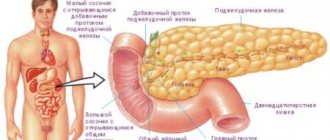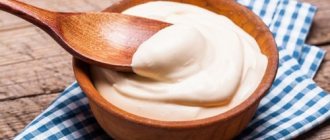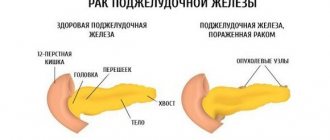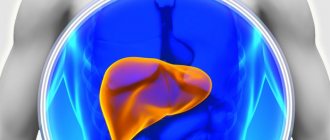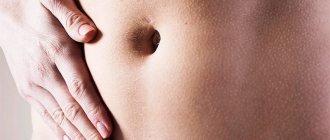The work of the internal digestive organs is interconnected. Violation of the functionality of one of them affects the others. The pancreas and liver have a special connection in the digestive system. These two organs produce the necessary amount of enzymes that are required for normal digestion of food. And if previously pathologies of the pancreas and liver were found mainly in people over 40 years of age, today they are becoming increasingly common among young people and school-age children. What are the reasons for the development of these pathologies? And how to treat the pancreas and liver?
Diseases of the liver, gallbladder and pancreas
Among the middle-aged population, the most common liver pathologies are:
- hepatitis, which comes in several forms - chronic, acute, toxic, viral;
- hepatosis;
- chronic renal failure;
- cirrhosis.
The most common gallbladder diseases are:
- dyskinesia;
- cholecystitis;
- bending of the gallbladder;
- cholelithiasis;
- gallbladder polyp.
And among the pathologies of the pancreas, the most often observed are:
- pancreatitis;
- cancer;
- diabetes.
Possible pathologies
Liver damage can be diffuse or focal. Diffuse nature is characterized by inflammation of organ tissues that occurs in diseases such as hepatitis, steatosis (accumulation of fat in liver cells), cholangitis, cirrhosis, and ulcers. Neoplasms of a malignant and benign nature appear in the form of foci. As in the case of the liver, the pancreas also suffers from focal and diffuse lesions. An example of diffuse changes is pancreatitis. When neglected, this disease becomes chronic. Exacerbations may also occur. And malignant tumors and other neoplasms appear in the form of focal lesions of the parenchymal structure.
Liver pathologies: causes and symptoms
The development of almost all diseases of the digestive system is most often associated with poor nutrition, which has had a negative impact on internal organs for a long time. But in addition to poor nutrition, liver function can also be affected by factors such as:
- infections (tuberculosis, hepatitis and others);
- poisoning with alcoholic beverages or medications (occurs with prolonged use);
- parasitic infestations;
- violation of metabolic processes;
- various pathologies of the circulatory system;
- sudden change in body weight.
When liver pathologies develop, a person may experience symptoms such as:
- change in skin color (as a rule, they acquire a yellowish tint);
- change in urine color (it becomes darker);
- the appearance of rashes and itching on the skin;
- constant presence of bitterness in the mouth;
- bloating and heartburn;
- swelling;
- increased body temperature;
- arrhythmia;
- lack of appetite, which causes weight loss.
What to take for liver pain at home. Longsuffering is not always a good thing
You are a happy person if you have never woken up in the middle of the night, tormented by the question: “My liver hurts, it aches in the right hypochondrium, what should I do?” And if you already woke up?.. The liver is the most “patient” organ of our body. She faithfully does her job of filtering the blood and “doesn’t complain” when she has a hard time. Although it would be better to “complain”...
The liver can perform its functions properly, even if only 20% of its percent is normal, and a person will not suspect that there is something wrong with his liver. Perhaps this “patience” is due to the fact that the liver’s ability to regenerate is truly unique (remember the Greek myth about Prometheus? An eagle pecked at his liver every day, but it was restored overnight. There is some truth in this story, no matter what you say).
One way or another, if a person experiences pain in the liver, this is already a sign of serious disturbances in its functioning. At least because the liver itself should not hurt: there are practically no nerve endings there. But the capsule in which the liver is enclosed “knows how” to hurt: if the liver enlarges, the capsule stretches, putting pressure on neighboring organs, hence the pain.
However, you cannot rely only on “it hurts or doesn’t hurt.” Firstly, if the liver has become so enlarged that it hurts, then this is already an advanced case, it is better not to let it get to that point. Secondly, pain in the right hypochondrium is not always a sign of problems with the liver: a person also has a gallbladder there, part of the intestines, part of the diaphragm... And in women, such pain can signal problems with the right ovary. In the end, it could even be appendicitis. So every person who cares about their health needs to know the various signs of liver problems in order to take the necessary measures in time and give the liver a chance to heal itself.
This is especially true for those who are at risk for liver disease. Are you fond of alcoholic drinks? Heavy food? Do you smoke? Do you work in a hazardous industry? Do you regularly take medications (such as oral contraceptives)? Do you have chronic inflammatory processes?.. Be more attentive to yourself. The presence of the factors described above is a reason to go to the doctor and get tested for liver enzymes and bilirubin, and at the same time undergo an ultrasound examination. Sometimes it's better to be safe, isn't it?
Pancreatic pathologies: causes and symptoms
The pancreas produces hormones and digestive enzymes. The following can lead to disruption of the functionality of this organ:
- poor nutrition;
- taking medications;
- drinking large amounts of alcohol, etc.
When the pancreas is damaged, a person may feel severe pain in the hypochondrium. Moreover, it can be localized in different areas - on the right or left side, in the center. It depends on which part of the organ was affected. Heartburn is also likely.
What diseases are important organs susceptible to?
Diseases of the liver and pancreas negatively affect other organs. The pancreas is responsible for the production of hormones (insulin, glucagon), enzymes necessary for the absorption of heavy foods.
Pancreatic lesions are of inflammatory, tumor and dystrophic origin:
- Pancreatitis is an acute or chronic inflammation, manifested in the form of pancreatic edema, false cysts, areas with fat necrosis or suppuration.
- Tumors (cancer, cyst). They have a different prognosis and almost always require surgical treatment.
- Lipomatosis. Degeneration of tissues and their replacement by fat cells.
The most common liver diseases:
- Hepatosis is dystrophy with necrosis of cells and their replacement with connective or adipose tissue.
- Hepatitis is a primary or secondary inflammation. The primary form, or viral hepatitis, is the result of damage by a hepatotropic virus. Secondary - a complication of another infection: sepsis, malaria, tuberculosis, etc.
- Fibrosis is the degeneration of organ cells into connective tissue.
- Cirrhosis is an irreversible transformation of tissue into fibrous tissue with loss of organ functionality.
Liver and pancreas treatment
How to cure the pancreas and liver? This question is asked by everyone who has encountered pathologies of these organs. However, it is worth immediately noting that chronic diseases are incurable. All a person can do is prolong the remission phase by maintaining special therapeutic diets. People with problems with the pancreas and liver are not recommended to eat:
- spicy;
- smoked;
- roast;
- fat;
- salty;
- flour.
Various sauces and canned food are also prohibited, as they contain various chemical compounds that can negatively affect the condition of the digestive system.
People who have pain in the liver and pancreas need to stop smoking and drinking alcohol. During these periods, they should eat exclusively healthy food. Vegetables and fruits should be chopped before consumption. To do this, you can grate them or puree them using a blender. Eating fatty meats and fish is contraindicated. For the first few days, it is recommended to exclude meat and fish dishes altogether to avoid putting unnecessary stress on the pancreas. As soon as the patient’s condition becomes satisfactory, fish and meat can be introduced into the diet, but in small portions. The advantage should still remain with vegetables and fruits. When preparing meat for a patient, you should know that it should be carefully prepared - rid of skin, veins, cartilage and films. Then the meat should be chopped and only then cooked from it. These can be quenelles, cutlets, soufflés and much more. However, remember that the use of hot seasonings, garlic and onions when preparing dishes for the patient is prohibited. And they should be cooked exclusively by steaming or in the oven without adding oil. Also remember that if you have diseases of the pancreas and liver, the consumption of fatty dairy products is strictly prohibited. That is, if you eat cottage cheese, then it should be 1%, and better yet, completely low-fat, if it is milk - no more than 2.5%, yogurt - 1.5%, etc. If your pancreas and liver hurt, then remember that a strict diet is the most effective way to treat them. You should not immediately resort to medications, as they can only increase the pain syndrome and lead to a deterioration in the patient’s well-being.
Diet for the day
- As a dietary breakfast and the beginning of the daily menu, if you have liver or pancreas disease, buckwheat porridge with half a teaspoon of butter or low-fat cottage cheese with a tablespoon of low-fat sour cream is suitable. You can wash down your breakfast with weak tea.
To properly prepare buckwheat porridge, which is healthy for the liver, means boiling the cereal in water, based on a 1:2 ratio, where 1 is part of the cereal, and 2 is water. Cook the porridge until the water has completely evaporated.
- For second breakfast, you can eat an apple baked in the oven as a snack. To diversify your diet, you can bake an apple with sugar or with cottage cheese, if cottage cheese was not used for the first breakfast.
To bake apples with cottage cheese for three servings (this recipe will appeal not only to dieters, but also to other family members), you will need the following products:
- 6 medium apples;
- 300 grams of cottage cheese;
- 1 egg white;
- a little sugar to taste;
- a tablespoon of sour cream.
First you need to preheat the oven to 180°C. While it is heating, wash the apples, cut them in half, taking out the middle. In place of the middle, use a tablespoon to strengthen the indentation. Mash the cottage cheese with sugar and sour cream until smooth and fill the apples with it. Place the apples on a baking sheet, put in the oven and bake for about 25 minutes; the sign of readiness will be the brownness of the cottage cheese and the softness of the apple. Once the apples have cooled, they are ready to serve.
- For lunch you can prepare vegetable puree soup (recipes for dietary soups are very diverse), for the second - noodles with meat dumplings and jelly.
Dumplings are a great way to diversify your daily diet. To prepare them, according to the recipe, you will need the following products:
- half a kilogram of chicken breasts or other lean and diet-allowed meat;
- a small piece of yesterday's bread;
- egg white;
- half a glass of milk without fat;
- a pinch of salt to taste.
Pass the meat and bread soaked in milk through a meat grinder or grind with a blender. If the doctor who prescribed the diet does not recommend adding bread to the quenelles recipe, they can be prepared without adding bread. Add egg white and mix thoroughly. Such cutlets are not sculpted by hand; they are either squeezed out of a pastry bag or separated using a tablespoon and a teaspoon.
A tablespoon of minced meat is taken from a common plate, and a teaspoon is packed into a steamer mold. If you don’t have a double boiler or multicooker, you can cook the quenelles in a saucepan, into which you place a colander and, without reaching the bottom, pour water. You can also boil the quenelles in water poured into a saucepan. The total cooking time, regardless of the chosen method, is 10 minutes, but it is better to cut it additionally and check when it is ready.
- In the afternoon, patients with impaired liver and pancreas function on a diet can have a snack of weak tea with biscuits, and for dinner prepare vegetable puree from potatoes or carrots with boiled fish fillet (or other fish dishes).
- Before going to bed, as a final touch to the day's nutrition, nutritionists recommend drinking a glass of low-fat kefir or pure yogurt.
Drug treatment of the liver and pancreas
The liver and pancreas are very sensitive organs. Therefore, you should never take any medications without the knowledge of your doctor. This can lead to spasm and severe pain, causing some to lose consciousness. Therefore, if you are worried about your pancreas or liver, seek help from your doctor. He will conduct an appropriate examination, identify the cause of your condition and prescribe the necessary medications. As a rule, for such pathologies, enzyme preparations are prescribed, which contain enzymes that facilitate the digestion process. However, their use is possible only during periods of remission. At the time of exacerbation, the stomach requires complete rest, so experts prescribe dietary table No. 5 and inject intravenous saline solution, which allows maintaining the functionality of the body. Then, depending on the patient’s condition and the cause of the pathology, the doctor prescribes treatment.
Symptoms of pain in the gallbladder, how to treat it?
The gallbladder is an important organ of the digestive system. It collects bile and releases it into the duodenum, thereby activating digestive enzymes in the intestines and emulsifying fats. In addition, the organ resorptions protein, salts, amino acids, secretes mucus and the hormone anticholecystokinin.
The gallbladder is very important for a person, and its diseases affect the condition of the entire body. The main symptom that indicates the presence of organ pathology is pain in the area of the right hypochondrium. Effective treatment is possible only after a correct diagnosis.
Why does my gallbladder hurt?
There are many reasons that cause unpleasant symptoms in the liver area.
But more often than others, doctors note: cholecystitis, stones, dyskinesia, genetic abnormalities and oncology.
Depending on what diseases are diagnosed, pain manifestations may differ slightly. You can understand this by analyzing your condition.
The most common causes are:
- bacteria;
- helminths;
- Giardia;
- fungi.
Cholecystitis can be of toxic or allergic origin. Microbes can enter the organ from the intestines, through the blood or lymph.
The trigger for the onset of inflammation is mainly too fatty, spicy foods, excessive overeating, alcohol, or if there is another disease accompanied by an inflammatory process, for example, pneumonia, pancreatitis, cholelithiasis, tonsillitis, gastritis.
Chronic cholecystitis is characterized by dull, aching (rarely sharp) pain in the liver area. The sensations are permanent and occur some time after eating “heavy” dishes. The pain radiates to the neck, right shoulder, and shoulder blade.
The syndrome is often accompanied by the following symptoms:
- bitterness or metallic taste in the mouth;
- nausea;
- flatulence;
- irritability;
- belching;
- insomnia.
Dyskinesia is a pathology of the gallbladder and biliary tract, which appears due to improper functioning of the organ and sphincters.
There are two types of pathology:
- Gallbladder dysfunction. This disease is characterized by a violation of the contractility of the organ. Appears against the background of hormonal imbalances, emotional stress, ulcers, stones, and so on, manifested by colic in the right hypochondrium.
- Sphincter of Oddi dysfunction. Signs of this pathology occur when the outflow of bile and pancreatic fluid into the duodenum is disrupted. This problem rarely occurs on its own; most often it manifests itself against the background of symptoms of peptic ulcers, cholelithiasis, cholecystitis, and so on.
The main causes of pathology are the following factors:
- neurosis;
- diseases of the endocrine system;
- obesity;
- allergy:
- inflammation in the pelvis;
- dysbacteriosis;
- use of hormonal contraceptives;
- poor nutrition;
- hepatitis;
- diseases of the bile ducts, pancreas, duodenum.
Biliary dyskinesia can be of two types: hyperkinetic and hypokinetic. With hyperkinetic pain, acute pain occurs in the area of the organ from time to time, radiating to the shoulder blade, shoulder, and left side of the chest. The pain appears suddenly and can be repeated several times throughout the day.
In addition, the following symptoms are observed:
- nausea;
- intestinal dysfunction;
- headache;
- excessive sweating;
- arrhythmia.
With hypokinetic pain, there is constant dull pain in the area of the right hypochondrium, “bloating,” bitterness in the mouth, poor appetite, bloating, and constipation. Symptoms worsen during mental stress or eating.
Such problems may not manifest themselves in any way and will be revealed by chance during examination, but very often the defects are expressed by pain of varying intensity and duration. Treatment depends on the complexity of the deviation and the performance of the organ.
Damage to the bile-storing organ is rare. Pathologies of this type are divided into open and closed. First, severe pain appears at the time of injury, but after some time the symptoms recur again with greater intensity. There is also limited muscle tone in the anterior abdominal wall.
In children, the gallbladder most often hurts due to the presence of parasites.
Parasitic lesions occur when:
- giardiasis;
- opisthorchiasis;
- strongyloidiasis;
- ascariasis;
- fascioliasis;
- clonorchiasis and so on.
In such cases, in addition to acute pain, there may be symptoms such as chills, intestinal dysfunction, fever, weight loss, itching, and blood eosinophilia. Against the background of parasitic pathology, inflammation of the organ may occur, which can lead to serious complications.
As for oncology, benign and malignant formations are distinguished. In the first option, there are no clinical signs. In the second, symptoms are not observed only at the initial stage.
With further development of the pathology, the following signs appear:
- constant intense pain;
- jaundice;
- anemia;
- sudden weight loss;
- ascites.
Diagnosis of the disease
Constant or regular pain in the area of the right hypochondrium in any case indicates a pathology of the organ.
Treatment is prescribed only after appropriate examinations.
To find out the reasons for the patient’s suffering, the doctor prescribes the following studies:
- Blood analysis. If ESR and leukocytes are elevated, we can talk about ongoing inflammatory processes.
- Duodenal sounding. This study makes it possible to determine the chemical composition of bile, the presence of leukocytes and mucus, cancer cells, and identify infectious agents.
- Ultrasonography. This examination makes it possible to see the bend, deformation of the organ, the thickness of its walls, the presence of stones, polyps, and dilation of the bile duct.
- Fine needle biopsy. This procedure is performed in cases where there is suspicion of cancer. It allows you to detect the presence of tumor cells.
- X-ray. Thanks to this study, the doctor assesses the size and deformation of the bladder.
- CT and MRI. Radiation examination of the organ allows us to identify pathology, even if there are very small inclusions and changes in the gallbladder.
Treatment of the liver and pancreas with folk remedies
Doctors strongly do not recommend resorting to traditional medicine, because it is not known how the digestive system will react to them. Today there is a huge selection of medications that can support the natural functioning of the pancreas and liver. Therefore, it makes absolutely no sense to take risks to save money. However, many still prefer to trust old, proven means. And some even manage to achieve positive results. Among the folk recipes for treating the pancreas and liver is:
- eating fresh cranberries;
- drinking a decoction prepared from parsnip root;
- consumption of dried films of chicken stomachs;
- drinking wormwood infusion;
- use of a golden mustache, etc.
However, remember that the use of folk remedies can also lead to a reverse reaction. Therefore, it is better to consult a doctor and check with him whether this or that method can be used in your case or not.
If you have pathologies of the pancreas, gallbladder or liver, then you will probably be interested in watching a video that indicates the causes of these diseases, as well as methods to prolong the remission stage.
Enzyme products
If a person experiences any symptoms of organ diseases, it is recommended to consult a specialist. You can consult a doctor - an endoscopist, who can do an endoscopy (on an empty stomach) and prescribe urine, blood, feces and other tests, as well as send for an ultrasound. You can also consult with a surgeon, and in cases of illness in a child, with a pediatrician. One of the main conditions for a speedy recovery, in addition to medications (or surgery), is diet.
In order to cure various diseases associated with the liver and pancreas, people very often resort to alternative treatment. It is worth remembering that this method can lead to dire consequences, so before starting treatment you should still consult a doctor. The use of such a folk medicine for children is highly discouraged.
Recipes:
- Take the fruits of dill, hawthorn, mint leaves, immortelle flowers and chamomile in equal parts and pour boiling water over it. After this decoction has infused, it should be strained and squeezed. Take the medicine 1 tablespoon after meals three times a day.
- Cumin, nettle and yarrow leaves are mixed with calamus root and also poured with boiling water. Take two spoons three times a day after meals.
- Valerian root, hawthorn, hop cones and chamomile are poured with boiling water, after which two tablespoons of the tincture are drunk at night.
Diseases of the liver and pancreas, the symptoms of which were described in the article, are unpleasant and fraught with consequences. Many people put off going to the hospital due to lack of time and money, but in any case, such serious diseases require proper and timely treatment and medical supervision. If you have any symptoms of illness, you should not put off visiting a doctor, as such a decision can have dire consequences.
To restore the pancreas, drugs with digestive enzymes are prescribed. Creon is rightfully considered the best representative of this group, but its use is not possible in all cases. It all depends on the body’s reaction to the drug, general condition, and how advanced the disease is. The data from the hardware and laboratory examination of the patient allow the gastroenterologist to select the correct dosage and course of treatment.
If indicated, the following drugs may be prescribed:
- Panzinorm.
- Pangrol.
- Pancreatin.
- Festal.
- Enzyme Forte.
- Mezim Forte.
- Ferestal.
Experts give preference to drugs containing pancreatin. This substance is a successful combination of protease, amylase, lipase. Enzymes promote quick and easy digestion of carbohydrates and proteins. Fiber also undergoes active breakdown. Thanks to high-quality processing, all elements are successfully absorbed in the small intestine.
It is important to consider that the course of treatment may take several months. It all depends on the degree of neglect of the pathology. For chronic pancreatic diseases, Festal is most often prescribed. In especially severe cases, the patient has to stop taking pills only during an exacerbation of the pathology.
In cases where inflammation of the pancreas is accompanied by additional swelling, the attending physician may prescribe a course of antienzymes. These include Kontrikal and Gordox.
Natural products containing a large number of biologically active substances can become a replacement or a successful addition to the medications of the main course of drug therapy. In childhood, with intolerance to certain groups of drugs, during pregnancy and lactation, many drugs are contraindicated. In this case, natural medicines remain the only way to cope with pancreatic pathologies.
Propolis is characterized by a high content of vitamins, minerals and active organic components. Regular intake of propolis 3 times a day helps stabilize the secretory activity of the pancreas. It is possible to restore internal organs with the help of honey, which is eaten 1 tbsp. on an empty stomach.
To combat the manifestations of pancreatitis, it is recommended to drink 100 g of potato juice before meals. For its preparation, only peeled good quality tubers are used. Potato juice quickly loses its beneficial properties, so it must be drunk immediately after preparation.
Oatmeal broth helps get rid of the negative effects of taking chemicals on the digestive system. To obtain it, pour 1 glass of oats into 1 liter of water and leave for 10-12 hours. Then cook over low heat for 30 minutes, remove and put in a dark place for 6 hours. After straining, the liquid is stored in the refrigerator. It is recommended to drink the medicine 3 times a day before meals.
Treatment of pancreatic pathologies requires complex therapy. The patient needs not only to get rid of unpleasant symptoms, but also to prevent their reappearance in the fastest and safest way possible.
In case of dysfunction of the gland and acute forms of the pathology, the patient is hospitalized. He is prescribed drug therapy, which includes
- medications that affect the secretion of gastric juice,
- enzyme preparations to compensate for their deficiency,
- analgesics, which help relieve pain,
- antispasmodics.
But without properly selected food products, treatment is reduced to zero. Therefore, diet plays a primary role in diseases of the pancreas.
Treatment with tablets has a number of advantages over other dosage forms:
- Passing through the gastrointestinal tract, they are absorbed through the stomach and intestines into the blood, beginning to affect the pancreas.
- Some drugs act directly on the intestines without entering the blood (for example, enzymes).
- The patient can control the intake of tablet forms himself. They can be taken independently at home.
- Tablets do not cause discomfort or pain, such as injections.
Taking medication in tablet form requires consulting a doctor and using it in precise dosages. Moreover, a number of drugs have contraindications and side effects. In addition, among them there are both inexpensive and expensive drugs.
Pancreatitis is not a disease that the body can cope with on its own. And the statement “it will go away on its own” with such a diagnosis is completely inappropriate. Treatment can take place at home or in a hospital based on the severity and extent of the disease.
Therapy should solve the following problems: eliminate pain, normalize the gastrointestinal tract and intestinal microflora, increase the level of enzymes to the desired value, restore hormonal balance. This requires proven and effective drugs that have already “proven” themselves in the fight against pancreatitis.
- Antispasmodics and analgesics - remedies for pain in the pancreas. Antispasmodics help remove spasms from the intestinal muscles. For additional pain relief, mixed types of drugs are used. In acute attacks, the first priority is to eliminate the pain syndrome.
— Means for compensating for enzymatic deficiency are enzymes, due to which gland dysfunction does not have such an effect on the digestive tract. Thanks to them, the functioning of the gastrointestinal tract is normalized, and the possibility of exacerbation of the disease is reduced. Enzymes are divided into:
- products that contain bile: they act effectively, but are not prescribed for gastrointestinal diseases,
- products consisting exclusively of enzymes: they are not taken for a long time, since the dysfunction of the pancreas increases, it ceases to produce enzymes itself.
— Antacids relieve secondary symptoms of the disease. Typically, with pancreatitis, an excess amount of hydrochloric acid is produced in the stomach, to neutralize which anticides are used. By reducing acidity, the destruction of enzymes is reduced.
— Antisecretory drugs have an analgesic effect, reduce the production of hydrochloric acid, and relieve abdominal syndrome. They are usually prescribed for chronic disease.
Treatment of pancreatitis during pregnancy is not an easy task. Relief of the condition is based on minimal medication and maximum use of dietary nutrition with limited fat intake, increased protein, vegetables and fruits in the diet. Antispasmodics are used to relieve pain; the choice of enzymatic preparations is small. The main treatment is prescribed after the birth of the child.
Medicines for pancreatitis and the course of treatment are prescribed by the doctor, based on the patient’s condition and examination results. It is important to complete the course of treatment so that the disease does not smoothly develop into a chronic form.
Homeopathy is widely used today in the treatment of various diseases. This form of treatment is based on the principle of similarity: if in large doses a drug can cause a disease, then in small doses it can cure it. This method of dealing with an illness can be treated differently, but it should not be ignored.
Homeopathy for the pancreas recommends a number of remedies aimed not only at relieving the disease, but also at recovery. For example:
- "Apis" helps well during exacerbations, relieving inflammatory processes;
- “Nux Vomica” normalizes the level of bile and its movement through the intestinal tract;
- "Lycopodium" is used for stagnation of bile;
- “Iris Versicolor” relieves pain by acting directly on the pancreas and is one of the best remedies.
After the exacerbation is stopped, all these homeopathic remedies can continue to be used by changing the degree of dilution and creating less concentrated solutions.
What is one of the common causes of pancreatic disease?
The functioning of the organs of the digestive system is closely interconnected. Failure in the functioning of one leads to disturbances in other organs. The pancreas and liver have a special connection.
Internal organs are located close to each other, have similar functionality, metabolic processes in the body depend on them, respectively, symptoms of liver and pancreas diseases are accompanied by a number of identical clinical manifestations.
The pancreas (PG) consists of a body, head and tail. It synthesizes the hormone insulin, which helps maintain glucose concentrations at the desired level. The organ also produces a number of enzymes that take part in the digestion process.
The liver acts as a “filter” between the digestive tract and the systemic circulation. Let's consider what is one of the common causes of pancreatic disease, and what symptoms signal a violation of the internal organs?
Causes of pathologies of the pancreas and liver
Only a doctor can thoroughly understand why the pancreas hurts. Sometimes, in order to get to the bottom of the true cause, an in-depth diagnosis, various procedures and examinations are necessary.
In most cases, pain occurs when the internal organ begins to digest itself. The first factor includes atherosclerotic changes, metabolic disorders, and abuse of proteins and fats.
In turn, this circumstance provokes increased production of digestive enzymes, which are responsible for the breakdown of food, while they aggressively affect the internal organ itself.
Causes of pancreatic disease:
- Bad habits - alcoholic drinks and smoking help to activate the production of pancreatic juice, which destroys the organ from the inside. In addition, they can indirectly affect the functionality of the pancreas by disrupting blood circulation in the body, which leads to the development of inflammation.
- Long-term drug treatment has a detrimental effect on the pancreas. The most harmful drugs include antibiotics belonging to the group of tetracyclines and corticosteroids.
- It is not uncommon to experience problems with the pancreas during pregnancy. This is due to the fact that the mother’s body works with double load; pregnant women often feel the need to eat something unusual or previously not typical for themselves, in particular, a fatty dish.
- Age-related changes in the body lead to impaired blood circulation, and as a result, pancreatic pathologies are detected.
The causes of pancreatic disease may lie in chronic stress, nervous tension, and poor environmental conditions. Often the impetus for the development of the disease is a combination of provoking factors.
In accordance with the anatomy, the pancreas and the human liver are located nearby.
There are many reasons for liver dysfunction. Let's look at some of them:
- Viral diseases provoke acute and chronic inflammatory processes in the liver tissue.
- Toxic effects. If harmful substances from the environment (chemical components, heavy metals, etc.) enter the human body for a long time, this leads to damage to the internal organ.
- Pathologies of infectious and parasitic nature. They can lead to pathological changes of an acute nature, or contribute to the development of chronic processes in the form of cystic changes in the liver.
- Genetic predisposition, acute diseases of the abdominal organs, injuries of the abdomen and liver, etc.
The liver is characterized by one of the highest regenerative abilities of all body tissues. The degree of organ damage largely depends on a person’s lifestyle.
Symptoms of liver, pancreas and gall bladder diseases
Search in progress Not found Show
The most common liver pathology is hepatitis, which is classified into several types. There are chronic, acute forms and toxic, viral forms. Diseases of the organ include chronic renal failure, hepatosis and cirrhosis.
Common diseases of the gallbladder are dyskinesia, cholecystitis, bend or polyp of the gallbladder, cholelithiasis. If the functionality of the pancreas is impaired, acute or chronic pancreatitis, internal organ cancer, diabetes mellitus, and dystrophy are diagnosed.
The key symptom of the pathologies described above is pain. The severity of the symptom is determined by the severity of the abnormal process in the body. The pain can be moderate or severe and occurs constantly or periodically. They have a stabbing and aching character. In some pictures, painful sensations appear in the heart area, often radiating to the right shoulder blade.
General symptoms of pathologies of the liver and pancreas:
- A disorder of the digestive tract, manifested by severe nausea, vomiting - sometimes multiple times, loss of appetite, loss of body weight.
- If you palpate the painful area, the pain intensifies, and you can feel the enlargement of the organ.
- Bloating, heartburn (always or periodically).
- Hormonal imbalance in the body.
- Insomnia or drowsiness.
- Increase in body temperature.
- Prolonged constipation, diarrhea, problems with bowel movements.
- Irritability, anxiety, nervousness.
- Change in color of stool, mucus is present in feces.
Voskresensky's symptom is also observed in pancreatitis. Of course, a sick person does not have the entire list of symptoms; most often, 2-4 obvious signs are diagnosed.
Each disease of the liver and pancreas differs in its course and clinical manifestations.
